
(American Traffic Solutions)
It’s one of the simplest rules of the road: If you see a Stop sign, stop.
This is especially important when that sign is attached to the side of a school bus that’s blocking your view of children about to cross the street from in front of it.
Nevertheless, studies have found that tens of thousands of times each day drivers literally ignore the signs and cruise right on by buses that are picking up or off-loading students.
For years, unless a police car was escorting the bus, it has been up to the bus driver to keep track of these scofflaws, marking down the license plate number, location of the incident and time of day. This, in turn, takes their attention away from their primary job of keeping an eye on their passengers safely entering and exiting the vehicle. As a result, enforcement has been low.
Now, new automated cameras attached to the sides of buses are making it easier for school systems and police departments to crack down on violators while allowing bus drivers to better focus on the task at hand.
A growing number of states, including Maryland and Georgia, have enacted laws recently that enable the use of the cameras. Charles Territo of American Traffic Solutions, one of the companies that manufacture and operate the systems, says they can monitor several lanes of traffic simultaneously, automatically detect a violation and gather all of the necessary data for a prosecution, including video and photo evidence. That information is then passed on to local law enforcement who determine if a violation indeed took place, manually run the plate and send a ticket to the owner of the car.
The Cobb County, Georgia, school district outside of Atlanta is one of the municipalities starting to install the cameras on its fleet of 1,000 buses, which make more than 80,000 stops a day. The district’s executive director of transportation, Rick Gresham, tells FoxNews.com that prior to their implementation, about 200 violations were reported each year. Now, in just one day during the first week of school this year, 67 violations were captured by the cameras, which are currently being used by 10 percent of the fleet.
According to the National Association of State Directors of Pupil Transportation (NASDPT) there are approximately 480,000 school buses in daily use across the nation, and the number of fatalities typically runs less than 20 annually, the majority of those involving crosswalk accidents. For the past two years, the organization has conducted a National Stop Arm Count, where a comprehensive report is kept of violations over the course of a day. This year, more than 88,000 violations were recorded by the 99,000 buses that participated.
As for the cost of implementing the system, Charles Territo of American Camera Solutions says that his company provides and installs the equipment free of charge and is paid a percentage of the fines issued, rather than working on a fixed contract. In Cobb County, violators are charged $300 for a first offense, $500 for a second and $1,000 for each one after that.
Bob Riley of the NASDPT says that the low price of the systems is key to their implementation given the relatively small number of accidents and fatalities involved. He notes that with increasingly tight budgets, many law enforcement agencies would rather focus their resources on efforts like DUI checkpoints, which are seen as more cost effective at keeping unsafe drivers off the road than assigning patrol cars to a bus route.
As for those drivers that are in too much of a hurry to obey the signs, Gresham has a message for them. “Our buses run close to schedule,” he says. “If you don’t want to get stuck behind one, try leaving for work five minutes earlier.”
You may save more than time if you do.